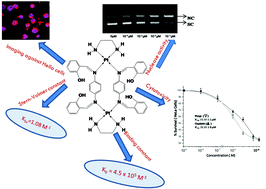Cytotoxic activity, cell imaging and photocleavage of DNA induced by a Pt(ii) cyclophane bearing 1,2 diamino ethane as a terminal ligand†
Abstract
A

* Corresponding authors
a Department of Chemistry, Faculty of Science, Banaras Hindu University, Varanasi, India
b Biochemistry & Molecular Biology Section, Centre of Advanced Studies in Zoology, Banaras Hindu University, Varanasi, India
c Department of Biochemistry, Faculty of Science, Banaras Hindu University, Varanasi, India
d Department of Chemistry, Cardiff University, UK
A

 Please wait while we load your content...
Something went wrong. Try again?
Please wait while we load your content...
Something went wrong. Try again?
N. Kumari, B. K. Maurya, R. K. Koiri, S. K. Trigun, S. Saripella, M. P. Coogan and L. Mishra, Med. Chem. Commun., 2011, 2, 1208 DOI: 10.1039/C1MD00159K
To request permission to reproduce material from this article, please go to the Copyright Clearance Center request page.
If you are an author contributing to an RSC publication, you do not need to request permission provided correct acknowledgement is given.
If you are the author of this article, you do not need to request permission to reproduce figures and diagrams provided correct acknowledgement is given. If you want to reproduce the whole article in a third-party publication (excluding your thesis/dissertation for which permission is not required) please go to the Copyright Clearance Center request page.
Read more about how to correctly acknowledge RSC content.
 Fetching data from CrossRef.
Fetching data from CrossRef.
This may take some time to load.
Loading related content
